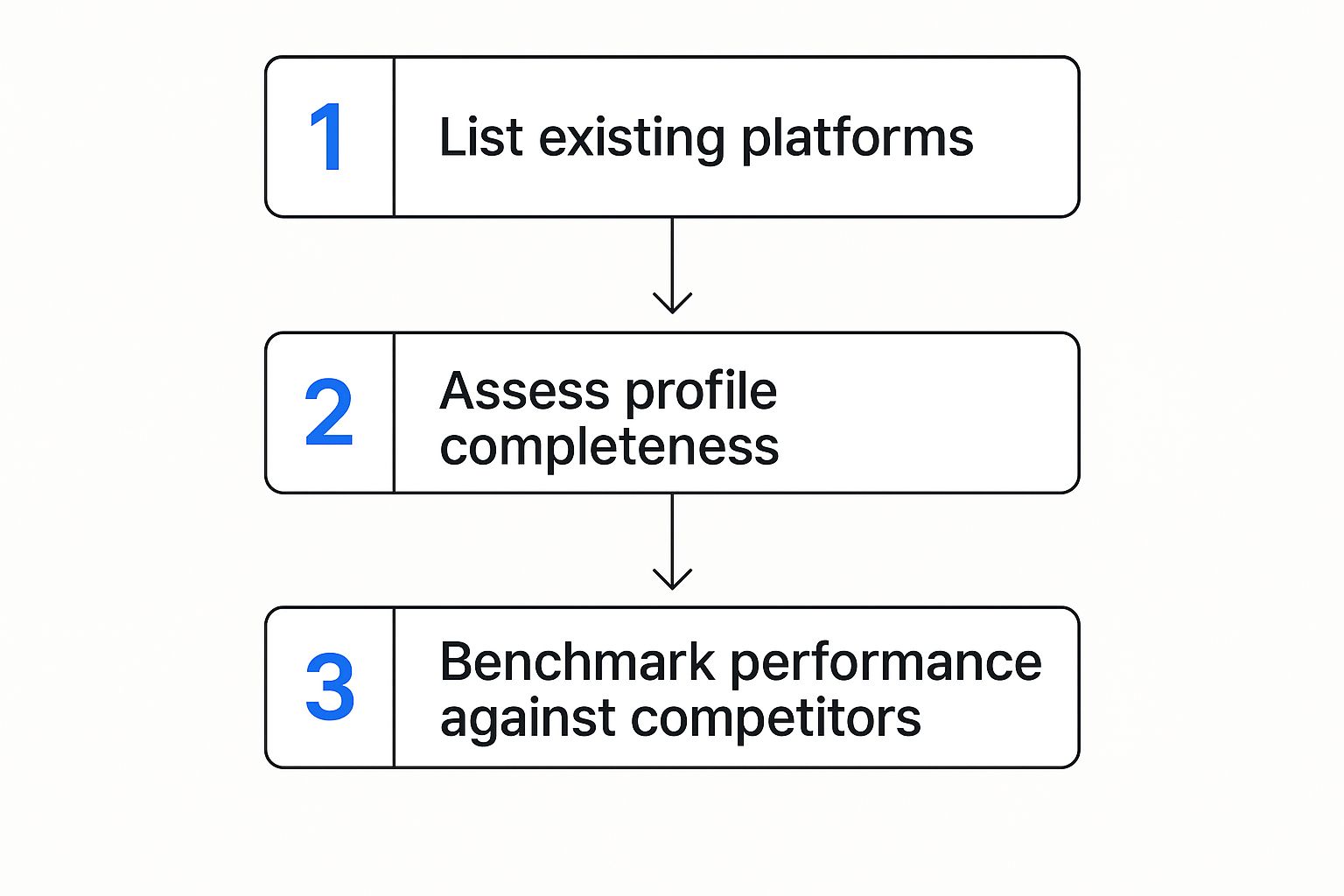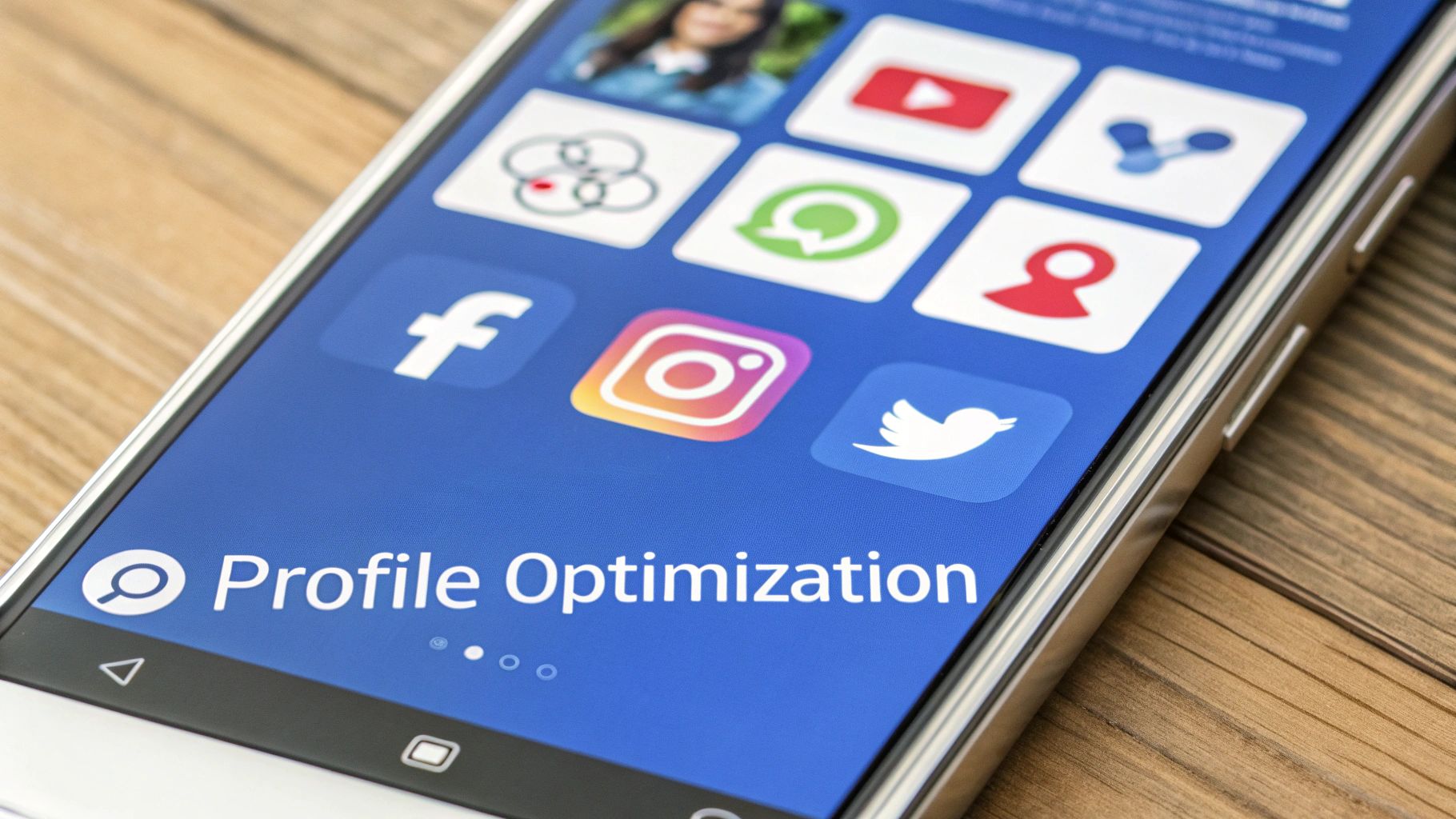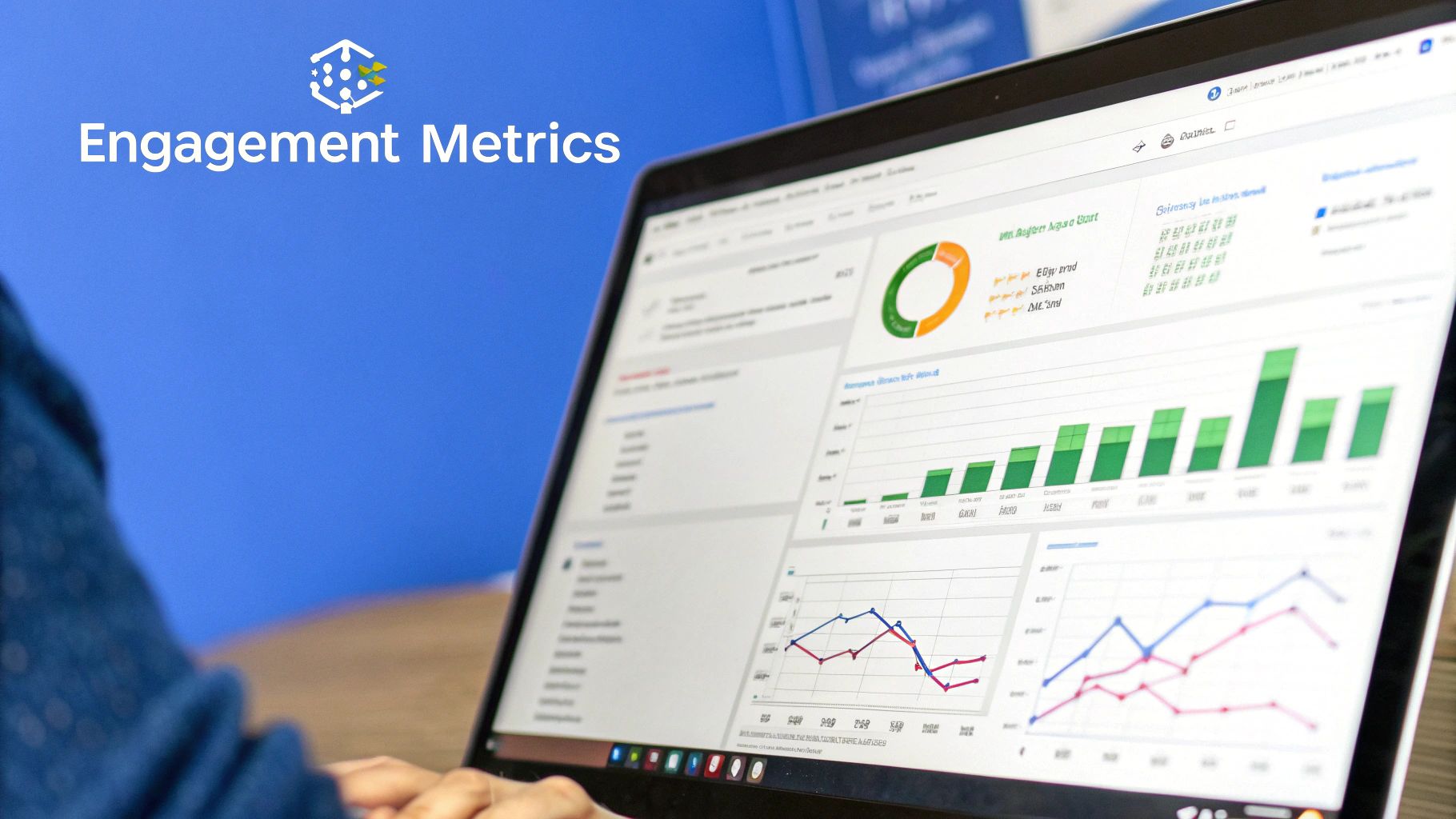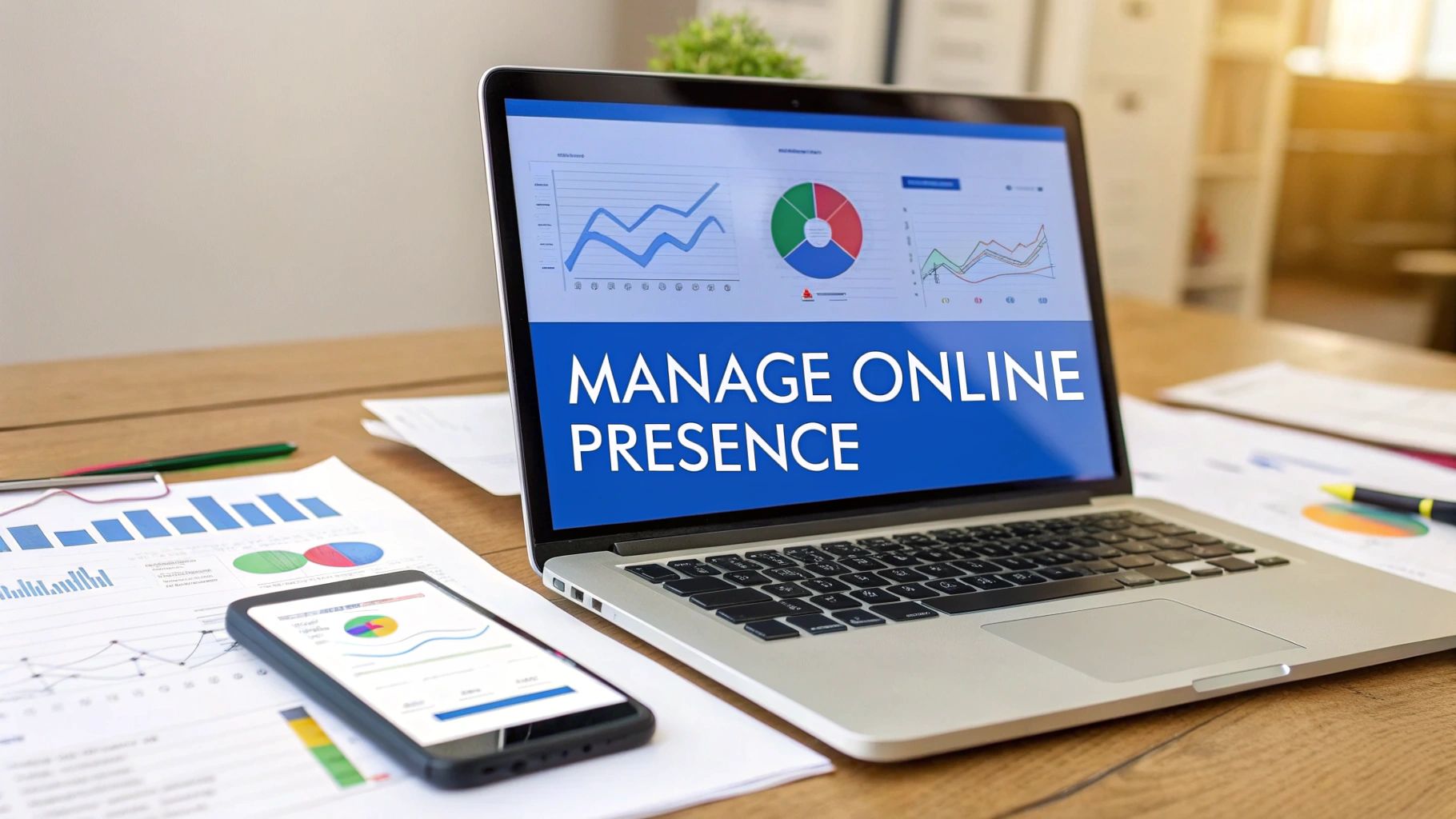Before you can really get a handle on your online presence, you have to get intentional about defining your digital identity. This is the bedrock. It involves taking a hard look at where you stand now, figuring out where you want to go, and developing a unique brand voice that ties everything you do together.
Defining Your Digital Identity

You wouldn't build a house without a blueprint, right? The same goes for your digital self. Managing your presence isn't just about posting on a whim or reacting to notifications; it's about building something with purpose.
The best place to start is with a simple, eye-opening digital audit. Pop open an incognito browser window and Google your name or your company's name. What pops up on that first page?
Take an honest look. Are the results positive, neutral, or kind of cringey? Do they paint the picture you want people to see? This first assessment gives you a baseline and often points out a few fires you need to put out immediately. It’s the raw material you have to work with.
Set Your Core Objectives
Once you know where you stand, you can set goals that actually mean something. A vague wish like "I want more followers" won't get you very far. You need to think about what you really want to accomplish.
For example, maybe your goals are to:
- Establish thought leadership in your industry by consistently sharing valuable insights.
- Attract new clients by showcasing glowing testimonials and past project successes.
- Build a strong professional network by connecting and talking with peers.
- Clean up your image to land better career opportunities.
These objectives become your north star. They guide every single decision, from the social media platforms you invest time in to the type of content you create. It’s how you turn random activity into a focused, effective strategy.
Your online presence is the story you tell the world without ever speaking a word. Make sure it's the one you want to be told.
Craft Your Brand Voice and Mission
A huge part of defining your digital identity is developing a consistent and authentic brand voice. It's the personality that shines through in your posts. Are you the witty, informal expert? The serious, authoritative guide? Or maybe you're all about inspiring and educating your audience.
Whatever you choose, it has to feel genuine. Faking a personality is exhausting, and people can usually see right through it. This is where a solid resource like the Ultimate Brand Voice Guide can be a game-changer, helping you nail down a voice that resonates.
Don't underestimate how important this is. As of April 2025, there were 5.64 billion internet users worldwide. With an audience that massive and fragmented across countless devices, having a clear, consistent identity is the only way to cut through the noise and make a real connection.
2. Pick Your Platforms Wisely
Trying to be everywhere at once is a classic rookie mistake. It's a surefire recipe for burnout, and worse, it makes your brand feel watered down and forgettable. You simply can't create high-impact content if you're spread too thin.
The real secret to managing a powerful online presence is putting your energy where it actually pays off. It’s about making smart, deliberate choices.
Think about it like this: a B2B consultant trying to land six-figure contracts isn't going to find them by posting dance challenges on TikTok. Their time is far better spent sharing deep industry analysis on LinkedIn. On the flip side, a freelance photographer’s career lives and dies by the visual portfolio they build on Instagram and Behance. It’s all about context.
A great starting point is to quickly audit where you are right now. This isn't a massive undertaking—just a simple check-in to see what's working and what's not.

As this flow shows, a solid audit means more than just listing your accounts. You have to honestly assess how complete your profiles are and how you stack up against others in your space.
Line Up Platforms With Your People and Your Goals
This is the most critical question you'll ask: Where does my ideal customer actually hang out online? Don't just guess or default to the big names like Facebook. Your audience might be hiding in plain sight in a niche community you've never even considered.
I’ve seen this play out time and time again.
- For B2B pros? LinkedIn is the obvious starting point for networking and establishing authority. But don't stop there. Niche Slack communities or industry-specific forums can be absolute goldmines for connecting directly with decision-makers.
- For visual creators? A stunning portfolio on Instagram, Pinterest, or Behance is non-negotiable. But to really build a following, showing your process through TikToks or YouTube Shorts can be a game-changer.
- For local businesses? Your Google Business Profile is your digital storefront—it's essential. Beyond that, platforms like local Facebook Groups can drive real foot traffic and build a loyal neighborhood following.
If you're looking for communities and tools to support your growth journey, a great resource I've come across is makerbox.io.
Your goal isn't to be everywhere. It's to be unforgettable where it matters most. Choosing fewer, more relevant platforms lets you create genuinely good content and build real relationships.
To help you map this out, here’s a simple framework I use to guide this decision.
Platform Selection Framework
| Platform | Primary Audience | Best For | Key Content Format |
|---|---|---|---|
| B2B Professionals, Corporate Leaders | Thought Leadership, Networking | Text Posts, Articles, Carousels | |
| Millennials, Gen Z, Visual Consumers | Brand Building, Visual Storytelling | High-Quality Images, Reels, Stories | |
| TikTok | Gen Z, Young Millennials | Viral Marketing, Behind-the-Scenes | Short-Form Vertical Video |
| Gen X, Millennials, Community Groups | Community Building, Local Ads | Videos, Events, Group Discussions | |
| X (Twitter) | Journalists, Tech, Professionals | Real-Time Updates, Public Convos | Short Text, Memes, Threads |
| Women (All Ages), DIYers, Planners | Driving Traffic, Product Discovery | Infographics, Guides, Product Pins |
Use this table as a starting point. Your own research into your specific audience will always be the final authority on where you should invest your time.
Tailor Your Content for Each Platform
Okay, so you've picked your channels. Now, please, resist the urge to just copy and paste the same message everywhere. It's lazy, and your audience can spot it from a mile away.
Every platform has its own vibe, its own unwritten rules, and its own preferred formats.
Think about how one great idea—like a comprehensive blog post—can be smartly repurposed:
- Pull out the key insights for a thoughtful text post or a sharp-looking carousel on LinkedIn.
- Turn the main points into a series of engaging Instagram Stories complete with polls and Q&A stickers.
- Summarize the top 3 takeaways in a punchy, fast-paced video for TikTok or Reels.
This isn't about creating more work; it's about working smarter. You're respecting the user's experience on each platform, which makes your content feel natural and way more effective. To really nail this, you’ll want to brush up on social media marketing best practices. By adapting your core message to fit each channel, you build a presence that’s cohesive but never boring.
Creating Content That Connects

Just showing up online isn’t going to cut it. You have to give people a compelling reason to follow, listen, and engage with you. This is where your content strategy becomes the real engine of your online presence, turning those passive followers into a genuine community.
It all boils down to building your content around a few core themes, which I like to call "content pillars." Think of these as the 2-4 foundational topics that scream, "This is what I'm an expert in."
For instance, a financial advisor might build their brand on pillars like Retirement Planning, Investment Strategies, and Wealth Building for Millennials. A freelance graphic designer? Their pillars could be Branding Fundamentals, Typography Tips, and A Day in the Life of a Freelancer.
When you have these core themes, you’ll never find yourself staring at a blank screen again. Every single piece of content you create should connect back to one of these pillars. This keeps your messaging laser-focused and consistently reinforces your authority.
Build A Sustainable Content Calendar
Let's be honest: a content calendar is your best friend if you want to manage your online presence without going crazy. It’s not about being rigid; it’s about having a flexible game plan that ensures you’re consistently sharing valuable stuff. That consistency is exactly what builds momentum and keeps your audience coming back.
Start by sketching out your pillars for the month. From there, you can get creative with formats. That "Retirement Planning" pillar could easily become:
- A deep-dive blog post that unpacks different types of retirement accounts.
- A quick, digestible video explaining a complex idea like compound interest.
- An Instagram carousel that visually highlights 5 common retirement mistakes.
- A LinkedIn poll asking your network about their biggest retirement worries.
This kind of variety is what keeps your feed from getting stale. Of course, posting is just one part of the puzzle. To really make an impact, you need to master your social media content strategy and learn what gets people talking.
Great content doesn't just inform; it sparks conversation and solves problems. Aim to create resources that your audience would thank you for sharing.
Diversify Your Content Formats
If you’re only sticking to one type of content, you’re leaving a massive opportunity on the table. People absorb information in all sorts of ways, and the media landscape has made that clearer than ever. Deloitte's research on digital media trends points to the explosive growth of social video, making it a non-negotiable part of any modern online strategy.
This means diversifying your output is essential. A well-rounded content mix that I’ve seen work wonders usually includes:
- Authoritative Blog Posts: These are your SEO powerhouses and provide incredible, in-depth value.
- Detailed Case Studies: Nothing works better for social proof and showing off real-world results.
- Authentic Short-Form Videos: Perfect for TikTok and Reels, they let your personality shine through.
- Interactive Polls and Q&As: A fantastic way to boost engagement and get direct feedback from your audience.
The trick is to create once and distribute many times. A single research report can be sliced and diced into dozens of smaller content assets. But creating amazing content is only half the battle—you still need to get eyeballs on it. Our guide on building a powerful https://www.getreplyguy.com/blog/content-promotion-strategy is a great place to start. By using multiple formats, you ensure you're connecting with your audience, no matter how they prefer to learn.
Mastering Engagement and Community Building
Building a solid online presence isn’t a one-way street where you just broadcast messages into the void. Think of it as a living, breathing conversation. If your content is the fuel, then genuine engagement is the fire that forges a real community. This is what separates brands with followers from brands with true advocates.
That shift in mindset is everything. You have to stop thinking about just "posting" and start focusing on "sparking discussions." The real goal isn't just to be seen, but to be heard and, even more importantly, to listen. When you consistently make people feel valued, they stop being a passive audience and become active, loyal members of your community.
Nurturing The Conversation
Engagement isn't an afterthought; it starts the second you hit "publish." In fact, your work is just getting started. Those first few hours after a piece of content goes live are the golden window for interaction. You need to be there, ready to answer questions, thank people for their comments, and add your own perspective to keep the ball rolling.
Let’s say someone leaves a really thoughtful comment on your latest LinkedIn article. Don't just give it a lazy "like." Reply with a follow-up question that digs deeper into what they said. This one simple action does two things: it encourages others to chime in and it proves you're actually interested in what your community thinks.
The most powerful way to manage your online presence is to treat every interaction as a chance to build a relationship, not just another metric to track.
Handling All Feedback With Grace
Let's be real—not every comment is going to be a rave review. And that's perfectly fine. How you handle criticism can say far more about your brand than how you handle praise. The trick is to respond thoughtfully, not just react emotionally.
Here’s a practical game plan for dealing with negative feedback:
- Acknowledge Promptly: A quick, public reply shows everyone you're paying attention.
- Empathize Sincerely: Start with something simple like, "I'm sorry to hear you had this experience." It goes a long way.
- Move to Private: Offer to sort out the specifics via direct message or email.
This strategy validates the person's feelings in public while you solve the actual problem behind the scenes. It's a professional look that can often turn a detractor into a fan. Mastering these moments is a huge part of developing effective social media engagement strategies.
Turning Followers Into Advocates
Ultimately, the pinnacle of community building is empowering your audience. A great way to do this is by encouraging user-generated content (UGC). Create a unique, branded hashtag and make a habit of featuring posts from your followers. When you put their content in the spotlight, you're not just giving them a platform—you're building powerful social proof.
For example, a software company could run a contest asking users to share their favorite, maybe lesser-known, feature. The best submissions get showcased on the company's main feed. This move generates a ton of authentic content, but more importantly, it creates a deep sense of belonging. Suddenly, you’re not just a brand they follow; you’re a community they're proud to be a part of.
Monitoring and Adapting Your Strategy

Here’s a hard truth: a great online strategy isn’t something you can set up once and then walk away from. If you’re not paying attention, you’re just guessing. To truly manage your online presence, you have to treat it as a living, breathing part of your brand that needs constant tuning based on real-world feedback.
The secret is to look past the vanity metrics. Sure, a high follower count looks nice, but it doesn't tell you the whole story. You need to focus on the numbers that actually show you’re making progress toward your real goals. It's about finding the signals in the noise.
Identifying Your Core Metrics
So, what should you actually be tracking? The answer lies in the goals you set for yourself in the first place. Your key performance indicators (KPIs) should be a direct reflection of what success looks like for you.
For instance, if you want to be seen as a thought leader, the engagement rate on your in-depth posts is your north star. If you're chasing new clients, then the click-through rate from your social profiles to your website is what really counts.
Here are a few essential metrics I always keep an eye on:
- Reach: How many unique people are actually seeing your content? This shows you if your message is spreading beyond your immediate circle.
- Engagement Rate: Are people just scrolling past, or are they stopping to like, comment, and share? This is a huge indicator of how relevant and compelling your content is.
- Click-Through Rate (CTR): This is a big one. Are people taking the next step and clicking the links you provide? This is crucial for driving traffic and leads.
- Audience Growth Rate: It's not just about how many followers you have, but how quickly you're attracting the right kind of followers.
Once you start looking at these numbers, patterns emerge. You might discover your impromptu, behind-the-scenes videos get massive engagement while your polished, text-heavy posts fall flat. That’s not a failure; it’s a road sign telling you where to invest your energy. To get even more granular on this, check out our guide on how to measure social media engagement.
Data isn't just about looking backward; it's about looking forward. Every insight is a breadcrumb showing you the path to better results and a stronger connection with your audience.
Using Tools to Track and Listen
You don’t have to spend hours buried in spreadsheets to do this. There are plenty of tools out there—both free and paid—that can do the heavy lifting for you.
For starters, every major social platform has its own built-in analytics dashboard. These are goldmines of information, offering insights into who your audience is and how your posts are performing. Dig in.
But don't just listen to what's happening on your own channels. You also need to know what people are saying about you across the wider web. Setting up alerts for your name or brand with tools like Google Alerts or a more robust platform like Brand24 is non-negotiable. This lets you jump on positive mentions, manage your reputation, and address any negative feedback before it snowballs.
Adapting Your Strategy for a Mobile World
Part of monitoring is keeping your finger on the pulse of broader digital shifts. The online world is overwhelmingly mobile. As of early 2025, with 5.56 billion people online, the small screen reigns supreme.
Consider this: nearly 96% of internet users get online with their phones. This mobile-first reality changes everything. It dictates your website’s design, the ideal length of your videos, and even the way you format your text. This stat alone, from the 2025 global digital report from We Are Social, is a powerful reminder that you have to meet your audience where they are.
Ultimately, building a powerful online presence is a continuous loop: you act, you measure the results, and you adapt. By staying curious, listening to the data, and being willing to pivot, your strategy will evolve from a rigid plan into a dynamic system that grows right alongside your audience.
Common Questions About Building an Online Presence
Once you decide to get serious about your online presence, the practical questions start piling up. It's totally normal to wonder about the nitty-gritty details of building and keeping up a strong digital footprint. I've gathered some of the most common questions I hear and provided some straight-to-the-point answers to help you navigate these challenges.
Think of this as a quick-start guide to clear up the confusion and give you a solid framework to work from.
How Much Time Should I Really Be Spending on This Every Day?
There’s no magic number here, but I can tell you from experience that consistency always beats intensity. It’s far better to dedicate 30-60 minutes of focused time each day than to cram everything into a frantic, multi-hour session once a week.
The trick is to break it down. You might spend 20 minutes actually talking to people in your community, 10 minutes scheduling your next post, and another few minutes checking your analytics to see what's working. When you use tools to schedule content in batches, you free up your daily time for genuine interaction—and that's where the real magic happens.
The biggest mistake I see people make is what I call "post and ghost." They broadcast their message and then disappear. You have to dedicate daily time to listening and responding. That’s how you build a presence people actually connect with.
What's the Best Way to Handle Negative Comments?
First, take a breath. It’s easy to react emotionally, but that rarely helps. Your first instinct might be to ignore or delete negative feedback, but don't—unless it's obvious spam or truly abusive. A quick, professional, and empathetic public response can completely defuse a tense situation and, even better, show everyone else watching how you handle yourself under pressure.
Here's a simple, effective formula I always recommend:
- Acknowledge the issue publicly so the person feels seen and heard.
- Show empathy for their bad experience. A little understanding goes a long way.
- Offer to take the conversation private (like DMs or email) to get the details and solve the problem.
For instance, a great reply looks something like this: "We're so sorry to hear you had this experience. That's definitely not the standard we aim for. Could you please DM us your order number so we can look into this and make it right?" This approach is a cornerstone of effective social media reputation management because it shows you’re responsive without getting into a public argument.
How Can I Be Consistent Across Different Platforms?
This is a big one. Consistency doesn't mean copy-pasting the exact same content everywhere—that just comes off as robotic and lazy. True consistency is about creating a unified brand feel through your voice and visuals, while tailoring the actual content to fit each platform's unique vibe.
Your brand's personality—whether it's witty, helpful, or professional—should be unmistakable no matter where someone finds you. Same goes for your logo and color palette.
But the content itself needs to be adapted. A single in-depth blog post can be brilliantly repurposed across your channels.
- Turn a key takeaway into a quick-tip video for TikTok or Instagram Reels.
- Create a visually appealing carousel graphic for Instagram.
- Use a compelling stat from the post to start a discussion on LinkedIn.
The core message remains the same, but the delivery feels native and natural to each platform. This is how you build a presence that feels authentic and cohesive, not just repetitive.
Are you an X creator trying to accelerate your audience growth? Stop scrolling endlessly and start engaging smarter. Reply Guy is a Chrome extension that pinpoints trending tweets on your timeline, helping you craft high-impact replies that ride the viral wave. Save hours, boost your impressions, and turn engagement into followers. Get your lifetime deal at https://www.getreplyguy.com.
